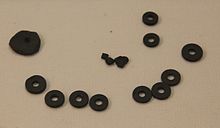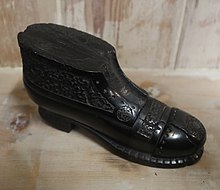Cannel coal

Cannel coal or candle coal is a type of
Composition
Cannel coal is brown to black oil shale.[3] It comes from resins, spores, waxes, and cutaneous and corky materials of terrestrial vascular plants, in part from
Cannel coal is also lower in fixed carbon than typical bituminous coal. It includes various amounts of
History

Cannel coal has been used as jewellery since the neolithic, with pieces appearing in Scotland (often alongside
In England a member of the Bradshaigh family discovered a plentiful shallow seam of smooth, hard, cannel coal on his estate, in Haigh, Lancashire in the 16th century.[8][9] The shallow depth at which it was found meant it was suitable for the simple surface mining methods available at that time. It could be worked and carved, and was prized for fireplaces as an excellent fuel that burned with a bright flame, was easily lit, and left virtually no ash.
Cannel coal commanded a premium price as a grate fuel for use in home fireplaces. It burned longer than wood, and had a clean, bright flame.[10] It is more compact and duller than ordinary coal[citation needed], and can be worked in the lathe and polished.[11] In the Durham coalfield and elsewhere carving cannel coal into ornaments was a popular pastime amongst the miners.
The excess of

On October 17, 1850,
In June 1857, a large gathering to celebrate the laying of a foundation stone of a pedestal on which to raise the retired Locomotion No 1 outside the Stockton and Darlington Railway Station (now North Road Station and Darlington Railway Museum - Head of Steam) witnessed that inside a special cavity in the pedestal were laid many items as a time capsule, and a cannel coal box made by a driver of the locomotive, Robert Murray, as a tribute to Edward Pease (often known as the "Father of the Railways").[13]
See also
References
- USGSGeological Survey Bulletin 1120. p. 7.
- ^ a b Hutton(1987)
- ^ a b Dyni (2006), pp. 3–4
- ^ a b Speight (2012), pp. 6–7
- ^ Han et al. (1999)
- ^ a b Stach (1975), p. 428
- S2CID 148566747. Retrieved 11 February 2017.
- ^ "Haigh Hall - England". Clanlindsay.com. Archived from the original on 2010-01-03. Retrieved 2013-03-30.
- ^ Manchester Engineers & Inventors (3), Manchester 2002, archived from the original on 2012-05-09, retrieved 18 April 2012
- ^ Ashley (1918), p. 35
- ^ a b Bauerman 1911, p. 576.
- ^ Ashley (1918), p. 43
- ^ D&S Times, June 13th, 1857, No 508, Columns 1, 2, 3 & pt4, The original Locomotive Engine
Bibliography
- Ashley, George H. (1918). Cannel Coal in the United States. Bulletin 659 (PDF) (Report). United States Department of the Interior, United States Geological Survey.
- This article incorporates text from a publication now in the public domain: Bauerman, Hilary (1911). "Coal". In Chisholm, Hugh (ed.). Encyclopædia Britannica. Vol. 6 (11th ed.). Cambridge University Press. pp. 574–585.
- Dyni, John R. (2006). Geology and resources of some world oil-shale deposits. Scientific Investigations Report 2005–5294 (PDF) (Report). United States Department of the Interior, United States Geological Survey.
- Han, Zhiwen; Kruge, Michale A.; Crelling, John C.; Bensley, David F. (1999). "Classification of torbanite and cannel coal: I. Insights from petrographic analysis of density fractions". International Journal of Coal Geology. 38 (3): 181–202. ISSN 0166-5162.
- Hutton, A.C. (1987). "Petrographic classification of oil shales". International Journal of Coal Geology. 8 (3): 203–231. ISSN 0166-5162.
- Speight, James G. (2012). Shale Oil Production Processes. ISBN 9780124017214.
- Stach, Erich (1975). Stach's Textbook of coal petrology (2 ed.). Berlin: ISBN 9783443010188.

